Hiroshima

Hiroshima (広島) is the principal city of the Chugoku Region and home to over a million inhabitants. When the first atomic bomb was dropped over Hiroshima on August 6, 1945, the city became known worldwide for this unenviable distinction. The destructive power of the bomb was tremendous and obliterated nearly everything within a two kilometer radius. After the war, great efforts were taken to rebuild the city. Predictions that the city would be uninhabitable proved false. Destroyed monuments of Hiroshima’s historical heritage, like Hiroshima Castle and Shukkeien Garden, were reconstructed. In the center of the city a large park was built and given a name that would reflect the aspirations of the re-born city: Peace Memorial Park.
![]()
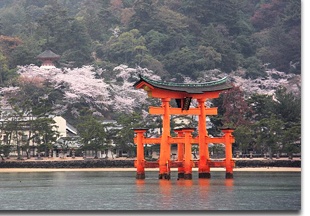
Miyajima is a small island less than an hour outside the city of Hiroshima. It is most famous for its giant torii gate, which at high tide seems to float on the water. The sight is ranked as one of Japan’s three best views. While officially named Itsukushima, the island is more commonly referred to as Miyajima, Japanese for “shrine island”. This is because the island is so closely related to its key shrine, Itsukushima Shrine, in the public’s mind. Like the torii gate, the shrine’s main buildings are built over water.
Miyajima is a romantic place, best enjoyed by staying overnight at one of the island’s ryokan. While there are usually many day tourists, in the evening the area becomes much quieter and more peaceful. There are also wild deer on the island that have become accustomed to people. In the day the deer wander around the same sites as the tourists, and in the evening they sleep along the walking paths.
Sapporo became world famous in 1972 when the Olympic Winter Games were held there. Today, the city is well known for its ramen, beer, and the annual snow festival held in February.
![]()
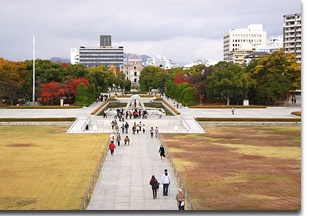
Hiroshima’s Peace Memorial Park (平和記念公園, Heiwa Kinen Kōen) is one of the most prominent features of the city. Even visitors not looking for it will likely stumble upon the large park of over 120,000 square meters. Its trees, lawns, and walking paths are in stark contrast to the surrounding downtown area.
Before the bomb, the area of what is now the Peace Park was the political and commercial heart of the city. For this reason, it was chosen as the pilot’s target. Four years to the day after the bomb was dropped, it was decided that the area would not be redeveloped but instead devoted to peace memorial facilities. The park’s main facility is the Peace Memorial Museum. Consisting of two buildings, the museum surveys the history of Hiroshima and the advent of the nuclear bomb. Its main focus though is on the events of August 6: the dropping of the bomb and its outcome in human suffering. The personal details displayed are quite upsetting and serve to remind that we should not take peace for granted.
![]()
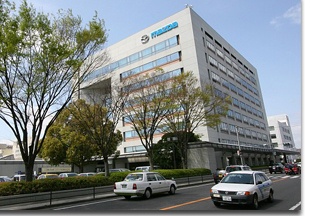
The Mazda Motor Corporation, founded in Hiroshima in 1920, still retains its corporate headquarters in the city of its origins. In addition to the headquarters, Mazda owns a large plot of coastal land which accommodates research and development laboratories, factories, and shipping facilities. The company museum and part of a factory are made available for public viewing.
Like Toyota to Nagoya, Mazda plays a large role in Hiroshima’s economy. Although Mazda is not as large as Toyota, it still produces over a million cars a year and is an innovative player in the Japanese auto industry. For instance, in 1991 Mazda became the first and only Japanese company to win the Le Mans Grand Prix. Continuing efforts to create more efficient vehicles include improving its version of rotary engines.
![]()
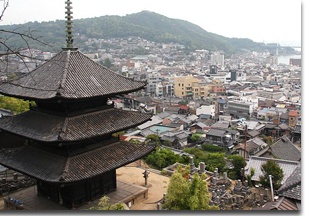
Onomichi (尾道) is a quaint town located along the Seto Inland Sea in eastern Hiroshima Prefecture. The town extends from the mainland across some of the neighboring islands, which are connected by the bridges of the Shimanami Kaido. Small ferries operate between the downtown area and the nearby islands, adding to Onomichi’s nostalgic port town atmosphere.
Onomichi is characterized by its many slopes, up and around which the town spreads. Many of the town’s attractions are located along the slopes, and visitors will need to walk up the narrow lanes that cut through the residential areas to reach them. Onomichi’s famous Temple Walk, for example, will take visitors up and down the slopes as it leads past the route’s 25 temples.
Despite its small size, the town of Onomichi has made significant contributions to both the literary and cinematic world. Respected authors and directors were born in the city, and it has been the filming location for numerous movies and television dramas.
![]()
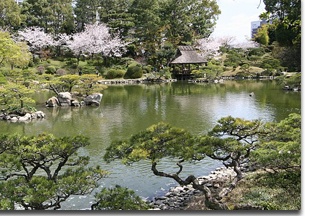
Shukkeien’s (縮景園) name can be translated into English as “shrunken-scenery garden”, which is also a good description of the garden itself. Valleys, mountains, and forests are represented in miniature in the garden’s landscapes. Through careful cultivation of the land and vegetation, the garden mimics a variety of natural formations and scenic views.
Shukkeien has a long history dating back to 1620, just after the completion of Hiroshima Castle. The garden displays many features of the traditional aesthetics of Japanese gardens. Around the garden’s main pond there are a number of tea houses which offer visitors ideal views of the surrounding scenery.
The entire garden is connected by a path which winds around the pond at the center of the garden. The path passes through all of Shukkeien’s various miniaturized sceneries. Following this path around the garden is the best way to enjoy Shukkeien.
![]()

Hiroshima has a bustling downtown area, the main feature of which is Hondori Street. Hondori is a pedestrian arcade that is closed to traffic and lined with shops and restaurants. It starts near the Peace Park and stretches east about half a kilometer. Running parallel to Hondori is Aioidori (Aioi Street), the main street used by cars and trams. Along Aioi Street stand a few large department stores where more shopping can be found.
While in the downtown area, visitors to Hiroshima may want to take the opportunity to try one of Hiroshima’s specialties: Hiroshima Style Okonomiyaki. Many restaurants along both Hondori and Aioi streets offer the local specialty, but the surest place to find it is in Okonomimura.
Usually translated as Okonomiyaki Village, Okonomimura is a small area just south of the eastern end of Hondori. As its name implies, it is devoted to okonomiyaki. Okonomimura has many different restaurants to choose from, and is a convenient place in the downtown area to take a break and grab a bite.

